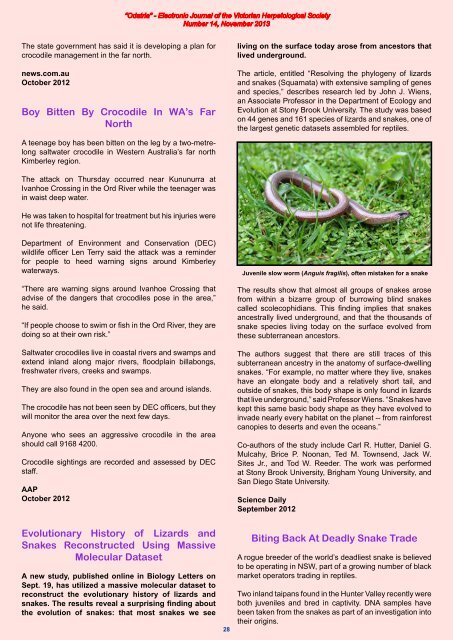Odatria_14_NOV13 - Victorian Herpetological Society
Odatria_14_NOV13 - Victorian Herpetological Society
Odatria_14_NOV13 - Victorian Herpetological Society
Create successful ePaper yourself
Turn your PDF publications into a flip-book with our unique Google optimized e-Paper software.
The state government has said it is developing a plan forcrocodile management in the far north.news.com.auOctober 2012Boy Bitten By Crocodile In WA’s FarNorthA teenage boy has been bitten on the leg by a two-metrelongsaltwater crocodile in Western Australia’s far northKimberley region.living on the surface today arose from ancestors thatlived underground.The article, entitled “Resolving the phylogeny of lizardsand snakes (Squamata) with extensive sampling of genesand species,” describes research led by John J. Wiens,an Associate Professor in the Department of Ecology andEvolution at Stony Brook University. The study was basedon 44 genes and 161 species of lizards and snakes, one ofthe largest genetic datasets assembled for reptiles.The attack on Thursday occurred near Kununurra atIvanhoe Crossing in the Ord River while the teenager wasin waist deep water.He was taken to hospital for treatment but his injuries werenot life threatening.Department of Environment and Conservation (DEC)wildlife officer Len Terry said the attack was a reminderfor people to heed warning signs around Kimberleywaterways.“There are warning signs around Ivanhoe Crossing thatadvise of the dangers that crocodiles pose in the area,”he said.“If people choose to swim or fish in the Ord River, they aredoing so at their own risk.”Saltwater crocodiles live in coastal rivers and swamps andextend inland along major rivers, floodplain billabongs,freshwater rivers, creeks and swamps.They are also found in the open sea and around islands.The crocodile has not been seen by DEC officers, but theywill monitor the area over the next few days.Anyone who sees an aggressive crocodile in the areashould call 9168 4200.Crocodile sightings are recorded and assessed by DECstaff.AAPOctober 2012Juvenile slow worm (Anguis fragilis), often mistaken for a snakeThe results show that almost all groups of snakes arosefrom within a bizarre group of burrowing blind snakescalled scolecophidians. This finding implies that snakesancestrally lived underground, and that the thousands ofsnake species living today on the surface evolved fromthese subterranean ancestors.The authors suggest that there are still traces of thissubterranean ancestry in the anatomy of surface-dwellingsnakes. “For example, no matter where they live, snakeshave an elongate body and a relatively short tail, andoutside of snakes, this body shape is only found in lizardsthat live underground,” said Professor Wiens. “Snakes havekept this same basic body shape as they have evolved toinvade nearly every habitat on the planet -- from rainforestcanopies to deserts and even the oceans.”Co-authors of the study include Carl R. Hutter, Daniel G.Mulcahy, Brice P. Noonan, Ted M. Townsend, Jack W.Sites Jr., and Tod W. Reeder. The work was performedat Stony Brook University, Brigham Young University, andSan Diego State University.Science DailySeptember 2012Evolutionary History of Lizards andSnakes Reconstructed Using MassiveMolecular DatasetA new study, published online in Biology Letters onSept. 19, has utilized a massive molecular dataset toreconstruct the evolutionary history of lizards andsnakes. The results reveal a surprising finding aboutthe evolution of snakes: that most snakes we see28Biting Back At Deadly Snake TradeA rogue breeder of the world’s deadliest snake is believedto be operating in NSW, part of a growing number of blackmarket operators trading in reptiles.Two inland taipans found in the Hunter Valley recently wereboth juveniles and bred in captivity. DNA samples havebeen taken from the snakes as part of an investigation intotheir origins.


